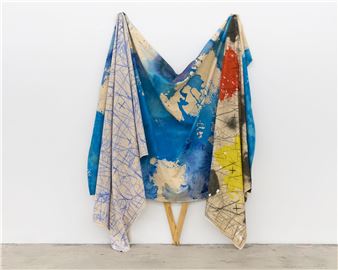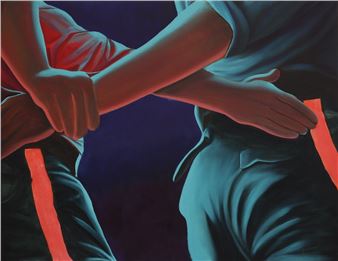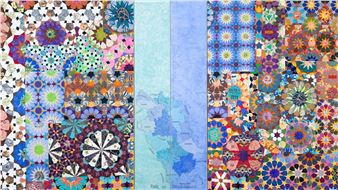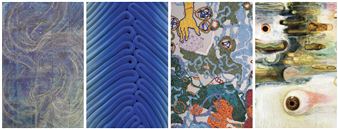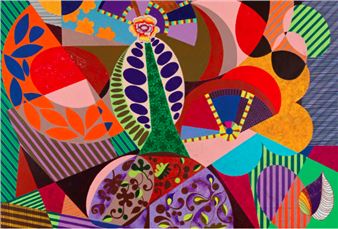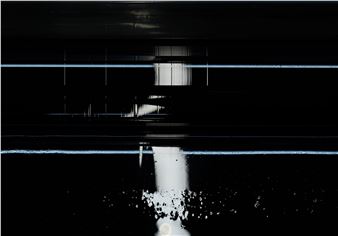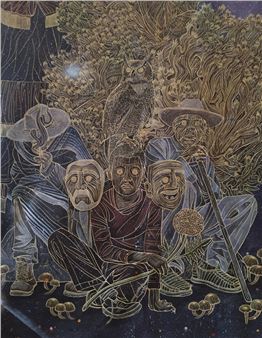Barbara Kasten: Intervals
Thomas Dane Gallery presents Intervals, the very first solo presentation in the UK of the internationally acclaimed artist Barbara Kasten (b. 1936). The exhibition displays both historic and recent works that showcase the Chicago-based artistвҖҷs striking oeuvre, which spans over 40 years.
Kasten herself speaks of her work as вҖҳPainting in motionвҖҷ, as it incorporates sculpture, photography and film, all of which contribute equally to the formation of her pieces. Her works are the results of extensive and carefully constructed installations, which she assembles in the studio by using вҖҳpropsвҖҷ like glass, mirrors, acrylic and metal elements, meticulously set up, solely for the camera. KastenвҖҷs work is strongly informed by Postmodern Design and Architecture as well as by Constructivism, not to mention the works and lives of Kazimir Malevich and LГЎzlГі Moholy-Nagy and the latterвҖҷs engagement with the Bauhaus School. Deeply shaped by the California Light and Space Movement in the 1970s, Kasten, who was trained as a sculptor and painter, began to challenge preconceived notions of these disciplines by making use of the photographic medium.
In her ground breaking series Construct, developed in the late 70s and early 80s and taken with a Polaroid camera, Kasten transformed building materials into tableaux whose composition, style and manipulation of space display a true painterly sensibility. In her recent series Transpositions (2014-2016) and her latest body of photographic work titled Collisions (2016), she uses Plexiglas elements to create large-scale compositions. The use of Plexiglas allows the artist to achieve a degree of transparency whilst simultaneously denying its own physical existence вҖ“ further intensified through the strong color saturations typical of the Cibachrome printвҖҷs surface, these works seem to amalgamate foreground and background to an abstract surface. KastenвҖҷs diligent treatise of material, undeniably tied to her insatiable drive to explore the mysticism of light, questions the very essence of the image-making process, a quality that seems to defy medium-specific categorisation. In light of the contemporary habit of taking images without necessarily materializing them, this tension between the object-ness of the вҖңthingвҖқ and the flat surface of the image adds a significant and growingly topical facet to her oeuvre.
A restless innovator, KastenвҖҷs most recent body of work takes on the form of a mixed media projection. Revolutions (2017) comprises characteristic components such as Plexiglas, neutral photographic backdrop paper and light, channelled through a moving image recording. For the first time in the artistвҖҷs career, these hitherto вҖңpassiveвҖқ elements, observed exclusively in their photographic reproduction, now step into 3-dimensional reality. Drawing from the paintings of Malevich, the work resonates with the findings of Suprematism, whose pursuit was to reach for the so-called zero degree of painting. Thus, Revolutions is structured by an algorithm, that creates repetitive and lingering elements which, darting to others, mimic habitual ways of examining works of art. Perceptually deceitful, or even illusionistic, solid material travels back and forth between sheer obscurity and physical presence: as with KastenвҖҷs photographic work, the scale and materiality are interchangeable and thus become co-dependent.
The transition to moving image in KastenвҖҷs oeuvre constitutes a metacommentary on the relationship between photography and film. The artistвҖҷs ongoing exploration of concepts rooted in art history and her experimentation with a wide variety of media, moving fluidly between the fine and applied arts, reveal an inquiry of the Constructivists endeavours to illuminate the interrelation of life, art, and technology. Always in sync with her times, yet in conversation with her predecessors, the ability of her imagery to transmit change and flexibility triggers an understanding of the present, which today seems utterly vital from our contemporary, digital perspective.
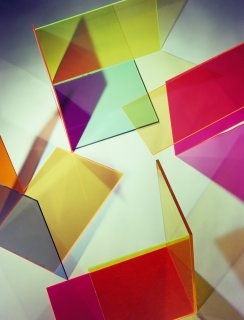
Recommended for you
Thomas Dane Gallery presents Intervals, the very first solo presentation in the UK of the internationally acclaimed artist Barbara Kasten (b. 1936). The exhibition displays both historic and recent works that showcase the Chicago-based artistвҖҷs striking oeuvre, which spans over 40 years.
Kasten herself speaks of her work as вҖҳPainting in motionвҖҷ, as it incorporates sculpture, photography and film, all of which contribute equally to the formation of her pieces. Her works are the results of extensive and carefully constructed installations, which she assembles in the studio by using вҖҳpropsвҖҷ like glass, mirrors, acrylic and metal elements, meticulously set up, solely for the camera. KastenвҖҷs work is strongly informed by Postmodern Design and Architecture as well as by Constructivism, not to mention the works and lives of Kazimir Malevich and LГЎzlГі Moholy-Nagy and the latterвҖҷs engagement with the Bauhaus School. Deeply shaped by the California Light and Space Movement in the 1970s, Kasten, who was trained as a sculptor and painter, began to challenge preconceived notions of these disciplines by making use of the photographic medium.
In her ground breaking series Construct, developed in the late 70s and early 80s and taken with a Polaroid camera, Kasten transformed building materials into tableaux whose composition, style and manipulation of space display a true painterly sensibility. In her recent series Transpositions (2014-2016) and her latest body of photographic work titled Collisions (2016), she uses Plexiglas elements to create large-scale compositions. The use of Plexiglas allows the artist to achieve a degree of transparency whilst simultaneously denying its own physical existence вҖ“ further intensified through the strong color saturations typical of the Cibachrome printвҖҷs surface, these works seem to amalgamate foreground and background to an abstract surface. KastenвҖҷs diligent treatise of material, undeniably tied to her insatiable drive to explore the mysticism of light, questions the very essence of the image-making process, a quality that seems to defy medium-specific categorisation. In light of the contemporary habit of taking images without necessarily materializing them, this tension between the object-ness of the вҖңthingвҖқ and the flat surface of the image adds a significant and growingly topical facet to her oeuvre.
A restless innovator, KastenвҖҷs most recent body of work takes on the form of a mixed media projection. Revolutions (2017) comprises characteristic components such as Plexiglas, neutral photographic backdrop paper and light, channelled through a moving image recording. For the first time in the artistвҖҷs career, these hitherto вҖңpassiveвҖқ elements, observed exclusively in their photographic reproduction, now step into 3-dimensional reality. Drawing from the paintings of Malevich, the work resonates with the findings of Suprematism, whose pursuit was to reach for the so-called zero degree of painting. Thus, Revolutions is structured by an algorithm, that creates repetitive and lingering elements which, darting to others, mimic habitual ways of examining works of art. Perceptually deceitful, or even illusionistic, solid material travels back and forth between sheer obscurity and physical presence: as with KastenвҖҷs photographic work, the scale and materiality are interchangeable and thus become co-dependent.
The transition to moving image in KastenвҖҷs oeuvre constitutes a metacommentary on the relationship between photography and film. The artistвҖҷs ongoing exploration of concepts rooted in art history and her experimentation with a wide variety of media, moving fluidly between the fine and applied arts, reveal an inquiry of the Constructivists endeavours to illuminate the interrelation of life, art, and technology. Always in sync with her times, yet in conversation with her predecessors, the ability of her imagery to transmit change and flexibility triggers an understanding of the present, which today seems utterly vital from our contemporary, digital perspective.

 ARTISTS
ARTISTS








